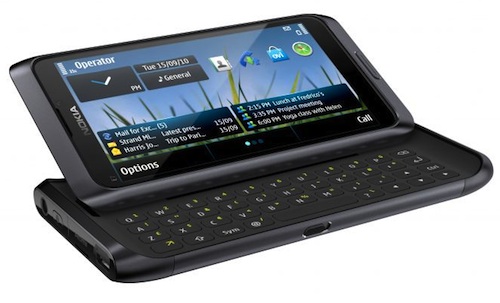
The E7 is proof that Nokia still makes great phone hardware. The huge, 4-inch Amoled screen, excellent slide-out Qwerty keyboard and sturdy design are all excellent.
However, as we stumbled our way around the clumsy Symbian^3 operating system software, we kept wondering: how much better would this phone have been if it ran Windows Phone 7 from Microsoft, Nokia’s new best friend?
A few years ago, before Google’s Android and Apple’s iOS, the fact that this device was running Symbian wouldn’t have given consumers pause. Like its spiritual predecessor, the business-minded E90, it would have flown off the shelves.
But the world, as Nokia CEO Stephen Elop so bluntly put it in his “burning platform” memo to the company’s staff, has changed dramatically. And Nokia is now in the uncomfortable position of having to play catch up in a smartphone market it once pioneered and led.
Consumers now have a dazzling array of choice. Whereas in the past Nokia was a logical — and a default — choice, many consumers have started trying out and learning to like the alternatives. Even some die-hard Nokia users are abandoning the company’s devices, enticed, in particular, by the lure of Android and iOS.
Of course, Nokia is far from being KO’d in this boxing match. Its market share remains formidable, especially in lower-cost handsets, and it has the talent to build the devices and applications that will resuscitate its fortunes.
The E7 provides clear evidence that the Finnish company knows how to build top-end hardware. The handset’s Amoled screen is simply stunning — it can be viewed clearly in direct sunlight — and Nokia’s cellphone camera technology is best in class. The 8-megapixel shooter on the E7 captures glorious images and even takes high-definition video clips at 720p. Plug it into a TV via HDMI and it even doubles as a rudimentary media server.
But in the world of smartphones, hardware is no longer the key selling point it was when devices like Nokia’s excellent E71 ruled the roost. Today, consumers are more interested in the software and services that the platform can deliver to them. It’s one of the reasons why Apple’s iPhone has been such a runaway success: it’s about the apps and music and services that Apple offers through the App Store. Similarly, Android has fast gained traction because of the extensibility offered by Google’s Android Market. Of course, high-quality handsets are still important, but they’re far from being the only decision that drives consumer choice.

It’s not that Nokia doesn’t know this. It just came late to the game. It now offers consumers an amazing range of services, such as free world maps with turn-by-turn navigation and affordable music downloads. Its Ovi Store has slowly gained traction, but the impression – correct or not – is that Nokia is still in a frantic bid to catch up to other app stores.
Elop’s decision to ditch Symbian in favour of Windows Phone 7 is the right move. In spite of Nokia’s best efforts to transform Symbian with Symbian^3, and to try to make it more comparable to modern rivals, the software is still clunky and old fashioned. It lets down the E7 badly.
First of all, the interface is not intuitive. It’s been fashioned out of Symbian written for old feature phones rather than designed from the ground up for newfangled smartphones. The sooner Nokia ditches the Symbian habit the better.
And there are plenty of little (and some not so little) niggles. For example, our review E7’s software updater constantly bombed out with the unhelpful message “update failed”, without giving any explanation as to why. Something as crucial as a software updater needs to work first time out the box without users having to search Web forums looking for answers.
Before you begin to think we detest the software, that’s not the case. Nokia has done a lot of work on improving Symbian — it’s just that it’s not in the same league as Android, iOS and Windows Phone 7. There are three home screens, which you can fill with widgets and applications, though switching between the screens is a tad too slow. And, finally, there are built-in social media apps for connecting to services such as Twitter and Facebook. However, third-party apps like TweetDeck — not available for Symbian — are better.
It bears repeating that the E7’s hardware is superb and is its key selling point. Some people will probably take issue with the fact that the battery is not user replaceable (an idea borrowed from Apple), but in most other respects, Nokia has got the design touches right. The E7’s camera is unobtrusive and the volume and screen-off sliders are stylish and well positioned.
The 176g device is no lightweight, but it’s not excessively heavy if you consider it has a full slide-out keyboard and a 640-360-pixel, 4-inch, capacitive-touch display. There’s also an assisted GPS, accelerometer, digital compass, cellular aerial supporting speeds up to 10,2Mbit/s, Wi-Fi (including the speedy “n” standard), FM radio and 16GB of on-board memory packed into its shell. Unfortunately, there’s no micro SD card slot, so forget about adding more capacity if you fill the 16GB.
The quality of the speakers is superb, with good bass and range, and, as is now common on modern Nokia handsets, there’s a 3,5mm audio jack and micro-USB port for charging and connecting to a PC.
Yet Nokia has a real challenge on its hands convincing consumers not to abandon its Symbian platform until it’s able to start churning out Windows Phone 7-based smartphones later this year or early in 2012. Once they’ve departed, they may be hard to lure back. Nokia’s Windows phones can’t come soon enough. — Duncan McLeod, TechCentral
- Recommended retail price: R5 999
- Subscribe to our free daily newsletter
- Follow us on Twitter or on Facebook

